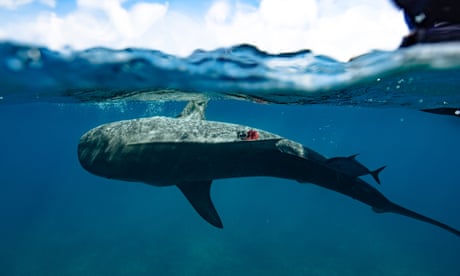Tiger sharks are notoriously fierce. The huge animals, which can grow to more than 16ft , are ruthless predators and scared of absolutely nothing – recent research found that while other shark species fled coastal waters during strong storms, tiger sharks “ didn’t even flinch ”. But recently they have a new role that could help burnish their reputations: marine scientists.
In an attempt to measure the extent of seagrass meadows in the Bahamas, researchers attached cameras and trackers to the dorsal fins of tiger sharks to give them access to hours of ocean floor footage. The data they collected revealed what the researchers say is the world’s largest known seagrass ecosystem, stretching across up to 92,000 sq km (35,000 sq miles) of Caribbean seabed. This discovery extends the total known global seagrass coverage by more than 40%, according to the study published in Nature Communications on 1 November.
“This finding shows how far are we from having explored the oceans, not just in the depths, but even in shallow areas,” said the report’s co-author, Prof Carlos Duarte, of Saudi Arabia’s King Abdullah University of Science and Technology. Seagrass meadows have long been under-researched – estimates of their total global area range wildly from 160,000 sq km to 1. 6m sq km.
Mapping is hugely challenging: meadows in deep or cloudy water cannot always be spotted by planes or satellites, while smaller ones can be sparse or interwoven with other marine plants making them tricky to identify. The problem with blue carbon: can seagrass be replanted … by hand? Read more This means seagrass meadows have to be “ground truthed” ie confirmed by someone – or something – at the site. But sending human divers to photograph vast tracts of ocean floor is expensive, logistically challenging and very slow.
Tiger sharks are a different story. The highly mobile animals are able to reach significant depths, have a large range and spend a lot of time in seagrass meadows. They are also unburdened by mundane human constraints such as needing a boat, having to surface frequently and reliance on calm ocean conditions.
Between 2016 and 2020, researchers fixed camera packages, equipped with satellite and radio tags, to the dorsal fins of seven sharks. They caught the animals using circle hook drumlines, which hook into the animals’ jaws. It is the “safest way to catch sharks” and causes no long term damage, said Oliver Shipley, a senior research scientist at Beneath the Waves, a marine science non-profit, and co-author of the report.
They reeled in the animals to affix the cameras in an operation Shipley likened to a that of a “Nascar pit crew”. It took about 10 minutes to tie on each bright orange camera using biodegradable cable ties and a dissolvable time-released swivel. After about six hours, the swivel corroded in the seawater and the whole package floated to the surface, where scientists could pick it up.
Sign up to Down to Earth Free weekly newsletter The planet’s most important stories. Get all the week’s environment news – the good, the bad and the essential Privacy Notice: Newsletters may contain info about charities, online ads, and content funded by outside parties. For more information see our Privacy Policy .
We use Google reCaptcha to protect our website and the Google Privacy Policy and Terms of Service apply. 00:22 Tiger sharks help scientists map seagrass in the Caribbean – video Using marine animals like this opens “a window on to the marine world” and can help answer questions about the climate and biodiversity crises, said Richard Unsworth, an associate professor at Swansea University and the founder of the Project Seagrass charity. Unsworth, who wasn’t involved in the study, said mapping seagrass is vital.
“If we don’t know where it is we can’t protect it,” he said. Seagrasses are important nurseries and feeding grounds for many marine species, they support commercial fisheries and provide a buffer against coastal erosion. They are also a significant source of “blue carbon” , trapping and storing vast amounts of carbon in the seabed, making them a vital tool in mitigating the climate crisis.
Yet they are threatened by a variety of factors including boating and shipping, coastal development and increasingly severe extreme weather. About 7% of seagrasses are estimated to be lost globally every year. The UK has lost 90% of its seagrass meadows over the past few centuries.
The researchers hope their discovery will mean better protections for seagrass in the Bahamas – which is threatened by dredging for coastal development as well as a push to mine for aragonite – but also worldwide. Seagrass, and other coastal ecosystems, are “probably one of the best allies and assets that we have in terms of naturally trying to mitigate the effects of climate change,” Shipley said. He predicts there will be many more projects partnering with marine animals to map ocean habitats.
“They are going take us to new places that we didn’t know existed. ”.
From: theguardian
URL: https://www.theguardian.com/environment/2022/nov/05/scientists-discover-worlds-largest-seagrass-forest-by-strapping-cameras-to-sharks



